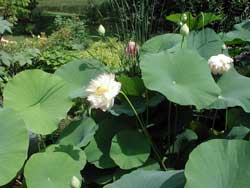Resource Library
Plant of the Week: Lotus
The University of Arkansas System Division of Agriculture does not promote, support or recommend plants featured in "Plant of the Week." Please consult your local Extension office for plants suitable for your region.
Plant of the Week
Lotus
Latin: Nelumbo nucifera

Water lilies have a tireless beauty in the summer months. Most gardeners don’t have water gardens, so these beauties often get mentally lumped into a category called “water lilies.” In reality, though, there are two very different kinds of hardy plants called water lilies; the ones with the notched, floating leaves (the true water lilies - Nymphaea) and the ones with non-notched leaves that stand above the water (the Nelumbo). It is this second group, the Lotus, which we will discuss today.
Nelumbo nucifera, lotus or sacred water lily of India, is one of two similar species of large, mud-anchored summer blooming perennial herbs. This species is native to a wide swath of Southeast Asia with India as its center of distribution while the other, very similar-appearing species, N. lutea, is native to the Southeastern United States.
Lotus grows from stout, wide-spreading rhizomes that are hardy as far north in areas where the mud at the bottom of the lake or pond does not freeze. Round leaves to 2 feet across are produced on centrally attached petioles to 6 feet or more long. The leaves are mostly held above the water.
The pinkish trending (sometimes white) lotus flowers are solitary, sweetly fragrant and up to as much as 12 inches across. Flowers have four or five petal-like sepals and 10 to 30 or more petals that surround a mass of yellow stamens. In the center of the nest of yellow stamens is the unusual flat-topped receptacle, which contains a number of large, solitary black seeds. N. nucifera tends to be larger than N. lutea, which also has yellow or white flowers.
Lotus flowers have a place of reverence among Hindu and Buddhist religions, where they represent purity. They have also been used extensively as a food source in both Asia and North America. Among Native Americans, the roots of “water chinquapin” were an important wintertime food resource. The large tubers are edible and can be fried, boiled or made into soups. The seeds can be eaten raw, popped like popcorn or made into a paste and then used for baking.
Lotus seeds have the distinction of being the oldest known seeds to have ever germinated. Thirteen hundred-year-old seeds (age based on carbon dating) found in a peat bog in China were successfully germinated in the 1970s, and the plants produced are occasionally offered in the water garden trade. The extremely thick, hard coating of the seeds perfectly seals the embryo, keeping it dry and in a state of suspended animation.
Lotus also helps encourage seed set by artificially warming its flowers to make a cozy home for visiting insects. With air temperatures as low as 50 degrees, flower temperatures are maintained above 85 degrees to encourage any passing insects to stop in for a visit and effect pollination.
Taxonomically, lotus has confused botanists since the time of Linnaeus. Though it grows in a watery habitat, it is not closely related to true water lilies. Current thinking, using cladistic classification techniques, places lotus as a close relative of the Southern Hemisphere proteas and, though it is hard to see, as a close relative of sycamore! Cladistic classification uses only shared traits to assess relationships, so sometimes some rather uncomfortable relationships emerge. At any rate, lotus is an ancient plant that dates back at least 100 million years and branches from the tree of life at an earlier point than true water lilies.
Lotus is hardy to zone 4 and can be grown in water as much as 6 feet deep. They require full sun conditions. In shallow farm ponds they tend to take over the entire pond, so the potential for uncontrolled spread should be considered carefully before planting directly into the mud. Most water gardeners find lotus to be among the easiest water plants to grow. The rhizomes are planted in a tub (with no drainage holes) half-filled with clay and placed in the pond. Every spring before growth begins the tub is removed, half of the rhizomes discarded and then replanted.
By: Gerald Klingaman, retired
Extension Horticulturist - Ornamentals
Extension News - July 30, 2010
The University of Arkansas System Division of Agriculture does not maintain lists of retail outlets where these plants can be purchased. Please check your local nursery or other retail outlets to ask about the availability of these plants for your growing area.